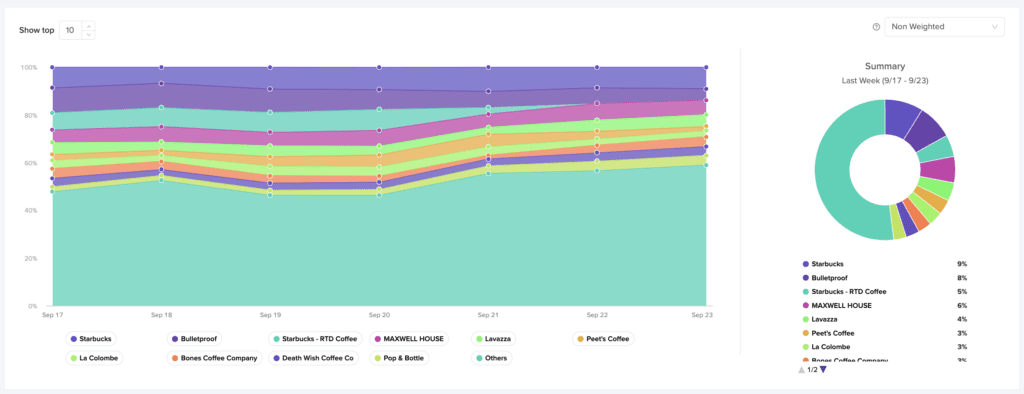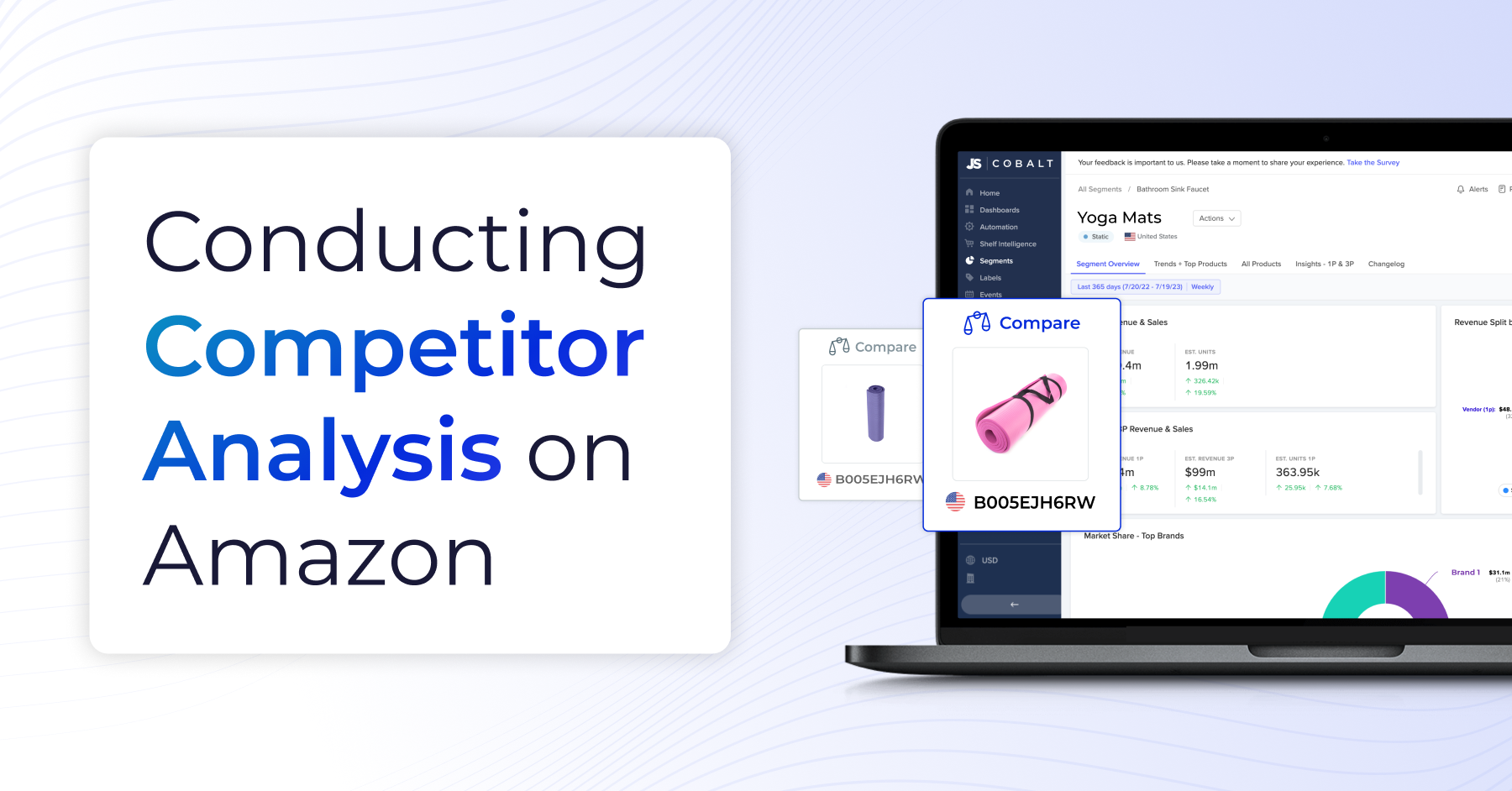Every day, roughly 3,700 new brands and sellers join Amazon. In the United States alone, there are more than 2.5 million products scattered across the platform’s virtual Storefronts. As competition continues to increase on Amazon and other ecommerce platforms, understanding your competitors’ strategies, strengths, and weaknesses is both more important and more complex. In this post, we’ll share tips for conducting thorough competitor analysis on Amazon and turning the insights you gather into effective strategies.
5 Questions to Ask About Your Amazon Competitors – And How to Answer Them
To conduct a comprehensive competitor analysis on Amazon, start by distinguishing between main competitors and secondary competitors. Ensuring you have a firm grasp of both helps you:
- Get ahead of emerging brands that could threaten market share
- Identify trends that are fueling growth for newer brands
For example, you may find that eco-friendly brands are on the rise in your category and, in turn, decide to launch eco-friendly versions of your own products.
Main competitors are brands that offer similar products or target the same customer segment as your brand.
Secondary competitors can include:
- Brands that offer similar products to yours but target a different customer segment (for example, luxury beauty products vs. everyday beauty products)
- Brands that offer products that are substitutes for your product (for example, cloth diapers as a substitute for disposables)
You should also identify tertiary competitors as part of your research. These are the brands that could become future competitors should you choose to expand into their markets. For example, if your brand sells hair care products, a tertiary competitor could be a brand like Dyson since it sells a number of hair styling tools.
Here are five questions to answer in order to find out who your top competitors are on Amazon and uncover opportunities to get ahead of the competition in your markets.
1. How competitive is my market niche?
Understanding how competitive your various market niches are will help you anticipate which of your products need a higher allocation of resources to stay visible and competitive. It will also help you identify market niches where competition is low, and you have a chance to introduce new products, increase sales, and grab market share.
Using Cobalt’s Market Intelligence solution, you can gather information on the competitive landscape in your market, including how many total brands and products are competing. You can see whether competition is increasing or decreasing over time and view a breakdown of products per brand to see which competitors are offering the highest number of ASINs within your market.

You can also view a breakdown of competitors by seller type, so you find and stop unauthorized 3P sellers who may be taking sales from you or track whether authorized resellers are following MAP agreements and other guidelines.
2. Who are my top competitors?
Consumers shop differently on Amazon than they do at stores like Target or Walmart – which means your biggest competitors on Amazon may differ from those your brand competes with in brick-and-mortar retail. On Amazon, shoppers tend to be less brand loyal, instead prioritizing price points, shipping speed, and other factors. There are also some brands that sell exclusively on Amazon, so you may not be aware of them without specific Amazon competitor research.
You can identify your Amazon competitors by looking at market share – one of the most valuable data points for analyzing the competitive landscape of your markets.
Cobalt offers a detailed look into how your brand’s market share fares against that of your competitors. Easily identify core competitors in a given product niche on Amazon by reviewing data on market share percentage and revenue for the brands competing in your space. You can customize your view to see market share by unit sales or by revenue and review this data for different time periods to see which brands are growing market share and which are losing traction.

It’s important to focus not just on the leaders in your market but rather on the brands that are closest to yours in terms of market share. If you’re launching a new product on Amazon for the first time, for example, you will begin with 0% market share – and thus your key competitors will initially be those brands with 1-5% market share as you work to grow in your market.
3. Which of my competitors’ products have the highest growth rates?
Understanding your competitors’ catalog performance is valuable for multiple reasons. It lets you know which specific products you’re competing against and dive into details about those products – like which variants sell the best and what features shoppers do and don’t like. These insights give you the information needed to optimize your product listings to highlight the qualities that shoppers value most. It also helps you pinpoint which of your competitors’ ASINs are worth targeting in your advertising campaigns and helps you stay in line with competitors when it comes to leveraging trends in the market.
Use Cobalt to view the top-selling products in your market overall and dig down to the brand level to see each of your competitors’ top-selling products. Filter data by sales or revenue, including insights on growth or decline over time. Once you’ve identified the products that are driving sales, you can analyze their listings and reviews to gather insights on how you can better position your own products to improve sales.

This data is also incredibly valuable for agencies that are helping client brands gauge competition and execute effective growth strategies:
“Agencies can use competitor comparisons in Cobalt’s Market Intelligence tool to report performance over time to existing clients or to show prospective clients the actionable strategies they will execute to make the client more competitive.” – Eva Hart, Amazon Growth Expert and Agency Owner, Jungle Scout Cobalt
4. How does my pricing strategy compare to that of my competitors?
Value is one of the biggest selling points for consumers. That’s why researching how other brands are pricing their products is a crucial part of effective competitor analysis on Amazon. This data will help you pinpoint the most effective price range for your own products. You want to avoid being overpriced, but you should also steer clear of having the lowest-priced option in the market, as that will devalue your brand.
In Cobalt, you can see average sale prices, both for your market overall and for individual products from your competitors. This includes trends over time, so you can gauge whether prices are going up or down. By viewing this data alongside sales trends, you can connect the dots between pricing and unit sales to see how shoppers are responding to cost changes in your market.

This data will help you avoid detrimental price adjustments that could result in lost sales and strategically launch discounts and promotions to drive shoppers to your products instead of those of competitors.
5. Who are the top brands on the digital shelf for my keywords?
Keywords are your ticket to visibility on Amazon. If you don’t know who you’re competing against for the search terms that lead shoppers to your products, then you’ll miss out on sales that end up going to your competition. Understanding who you’re up against will help you determine how to allocate your advertising budget and how to optimize your listings. You need to know not just which brands you’re competing against but how share of voice (SOV) is split for top keywords so you can make wise decisions about where to funnel your resources.
You can dig into keyword competition with Jungle Scout Cobalt’s Digital Shelf Analytics. Upload a list of keywords to see which brands are ranking for those keywords and how their SOV fluctuates over time. This allows you to differentiate between top competitors for organic vs. sponsored search, as well as between SOV leaders for different types of sponsored placements.
This level of granularity ensures not only that you find all of your competitors but also that you have targeted data upon which to build sound organic and paid strategies.

Be sure to analyze both generic and branded keywords to see where competitors are ranking for the keywords that are most likely to fuel sales of your products. You can then initiate tactics to protect those keywords from competitors:
“You can use Cobalt’s Ad Accelerator feature to help protect your branded keywords by setting custom budget allocations that automatically increase bidding when competitors’ products show up in searches for your brand.” – Eva Hart, Amazon Growth Expert and Agency Owner, Jungle Scout Cobalt
Putting Amazon Competitor Analysis into Action
Once you have collected and analyzed the data from your competitor analysis, it’s time to put it into action and build strategies to overtake your competitors on Amazon. Here are five tips to guide you:
1. Emphasize differentiation and unique selling points
Use the insights gained from your competitor analysis to emphasize your unique selling points and create compelling value propositions. You can do this by:
- Optimizing your listings with content that highlights where your products excel and addresses gaps in your competitors’ offerings
- Enhancing your product features
- Launching new product variants
- Improving product packaging
- Offering additional value through bundles and exclusive offers
2. Refine your marketing strategy
Armed with the knowledge you’ve gained from your competitor analysis, refine your marketing tactics, messaging, and channels. Look for opportunities to:
- Develop targeted marketing campaigns that showcase your competitive advantages
- Use the insights you’ve gathered on competitors’ pricing, product reviews, sales trends, and more to address customer pain points directly
- Leverage social media platforms, influencer partnerships, and other off-Amazon marketing tactics to increase your brand’s visibility.
3. Optimize pricing and promotions
Pricing plays a critical role in shoppers’ purchase decisions. Based on your competitor analysis, adjust your pricing strategy to ensure it remains competitive without compromising profitability. Leverage the information you’ve gathered on competitors’ promotional activities to:
- Develop effective promotional campaigns of your own
- Offer limited-time discounts, bundles, subscription discounts, and more to incentivize shoppers to choose your products over competitors
- Use data on competitors’ sales over time to identify seasonality and other trends that can help you strategically time your promotions and discounts
4. Improve your advertising campaigns
After identifying the keywords your competitors are targeting and the ad placements they use, you can leverage this information to optimize your own advertising efforts by:
- Developing targeted keyword strategies
- Creating compelling videos and other ad content
- Experimenting with different ad formats to maximize your visibility and attract customers
- Regularly monitoring the performance of your ads
- A/B testing campaigns to continually refine your tactics
- Taking advantage of automation to quickly make bid adjustments that improve your SOV
5. Monitor and adapt
Conducting effective competitor analysis on Amazon is an ongoing process. Continuously monitor your competitors by:
- Tracking their new product launches
- Watching for pricing changes
- Analyzing their marketing campaigns
Consistent tracking is the key to staying nimble and adapting your strategies to stay ahead of the competition.
Competitor Analysis on Amazon: The Key to Staying Ahead
Continuous, thorough competitor research is essential for brands and retailers selling on Amazon. The ecommerce landscape is ever-changing, so it’s crucial to continuously monitor your competitors so you can adapt your strategies to stay ahead. By identifying key competitors, analyzing their strategies, and putting the collected data into action, you can build effective strategies to outperform your competitors and drive growth.
Jungle Scout Cobalt makes the process more efficient and effective, providing insights that can be transformed into strategies that differentiate your products, improve your advertising campaigns, and drive sales on Amazon.

 No Comments
No Comments